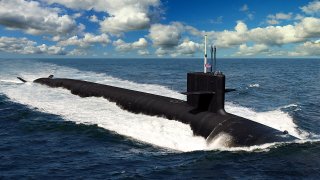Columbia-Class: The Stealth Missile Sub the U.S. Navy Is 'Drooling' Over
The Columbia-class ballistic missile submarines (SSBN) are set to replace the aging Ohio-class, ensuring the U.S. Navy maintains its sea-based nuclear deterrent into the 2080s.
Summary: The Columbia-class ballistic missile submarines (SSBN) are set to replace the aging Ohio-class, ensuring the U.S. Navy maintains its sea-based nuclear deterrent into the 2080s.
-These new subs feature an electric-drive propulsion system, making them the quietest yet, and are armed with 16 Trident II D5LE missiles, capable of delivering multiple warheads.
-Designed for a 42-year service life without reactor refueling, the Columbia-class minimizes logistical issues in U.S. shipyards.
-However, budget constraints and potential global strategic shifts could force the Navy to focus on hemispheric defense.
-Additionally, the Navy may consider converting some of these subs into guided-missile versions for non-nuclear missions.
Understanding the Role of the Columbia-class Submarine
Columbia-class ballistic missile submarines (SSBN) were intended to replace the U.S. Navy’s aging Ohio-class SSBNs, which have been in service since the 1980s.
The Columbia class was designed to maintain a credible nuclear deterrent. Despite the importance of this task, the cost of the new class has imposed some constraints on the Navy’s already strained budget, affecting the overall development of the program and the production of the system.
These delays risk further straining the Navy at the strategic level, since more Ohio-class submarines that were considered old and in need of retirement must be kept operational longer than planned.
The Importance of This Sub
On paper, the Navy is planning for Columbia-class submarines to maintain America’s sea-based nuclear deterrence until at least the 2080s, meaning that the Navy’s investment in the Columbia-class program is a significant long-term move.
The Ohio-class nuclear submarines and their Columbia-class replacements are key elements in America’s nuclear triad. Basically, modern nuclear powers want nuclear weapons to operate on land, at sea, and in the air in order to stymie attempts by rival nuclear states to launch decapitating strikes at their arsenal.
By keeping the weapons in this triad formation, the U.S. ensures they will always have the ability to retaliate against a nuclear attack. This creates problems for the already stretched force – it cannot cover all the areas in the world it is tasked with covering.
The Specs
America’s Columbia-class SSBNs, though, have some interesting features that explain why the Navy is so committed to building these boats. One of the most important is that the Columbia class is slated to be the quietest ever. This not only enhances their strategic strike capabilities, but it also makes it harder for enemy subs to track and destroy them.
Columbia-class subs have a brand new electric-drive propulsion system, thereby ensuring greater speed, better maneuverability, enhanced efficiency, and lower acoustic signatures. The new propulsion system is still nuclear, but the drive system converts nuclear energy directly into electrical power. Thus the noise the engines make on this class of submarine is much less than what it is on other American nuclear-powered subs.
As for arms, the Columbia class will be equipped with 16 Trident II D5LE (Life Extension) missiles. Each is capable of delivering multiple independently targetable re-entry vehicles (MIRVs). This is the nuclear armament that makes the Columbia class such an important boat.
These subs are designed for a 42-year service life. The Navy designed them to not require any mid-life reactor refueling. This is a smart move in general. But it might indicate deeper concerns on the part of Navy planners that America’s shipyards are unable to meet peacetime demands for the Navy. Rather than risk putting these important submarines into shipyards that may struggle with delays for mid-life reactor fuelings, the Navy cut out the need for them entirely.
Toward a Strategy of Hemispheric Defense?
Much as happened with the Ohio-class submarines over time, the Navy is already discussing the possibility of converting some future Columbia-class submarines into guided-missile subs (SSGNs).
The Ohio class was created for SSBN classifications only. Over time, however, the Navy converted some into SSGNs. An SSGN is capable of conducting land attacks with non-nuclear cruise missiles. In the post-Cold War era, when the U.S. Navy was the undisputed hegemon of the high seas, this was a practical move.
By the time the Columbia-class submarines reach their full maturation, it is unlikely that the strategic situation in the world will resemble anything like the 1990s. Indeed, the United States will likely need as many nuclear-armed submarines as possible.
What’s more, it is likely that, over the coming two decades, the Navy will be increasingly relegated to hemispheric defense as opposed to power projection.
Thus, having a sea-based nuclear deterrent will be key to preventing American rivals from effectively turning our own hemisphere against us.
Author Experience and Expertise: Brandon J. Weichert
Brandon J. Weichert, a National Interest national security analyst, is a former Congressional staffer and geopolitical analyst who is a contributor at The Washington Times, the Asia Times, and The-Pipeline. He is the author of Winning Space: How America Remains a Superpower, Biohacked: China’s Race to Control Life, and The Shadow War: Iran’s Quest for Supremacy. His next book, A Disaster of Our Own Making: How the West Lost Ukraine, is due October 22 from Encounter Books. Weichert can be followed via Twitter @WeTheBrandon.
All images are Creative Commons or Shutterstock.
From the Vault
Russia Freaked Out: Why the U.S. Navy 'Unretired' the Iowa-Class Battleships
Battleship vs. Battlecruiser: Iowa-Class vs. Russia's Kirov-Class (Who Wins?)


